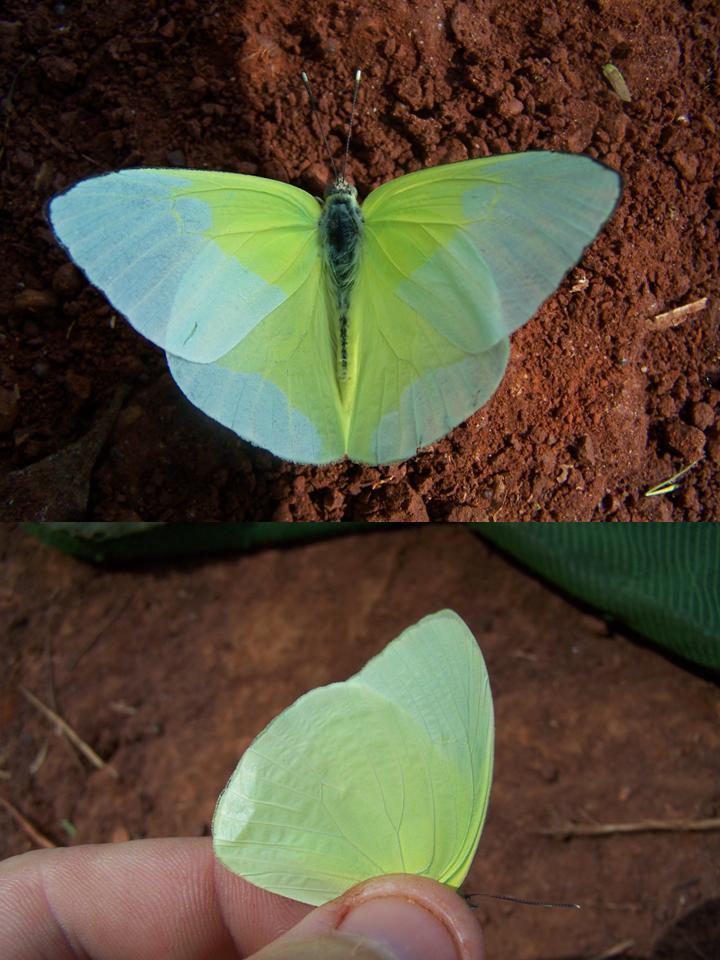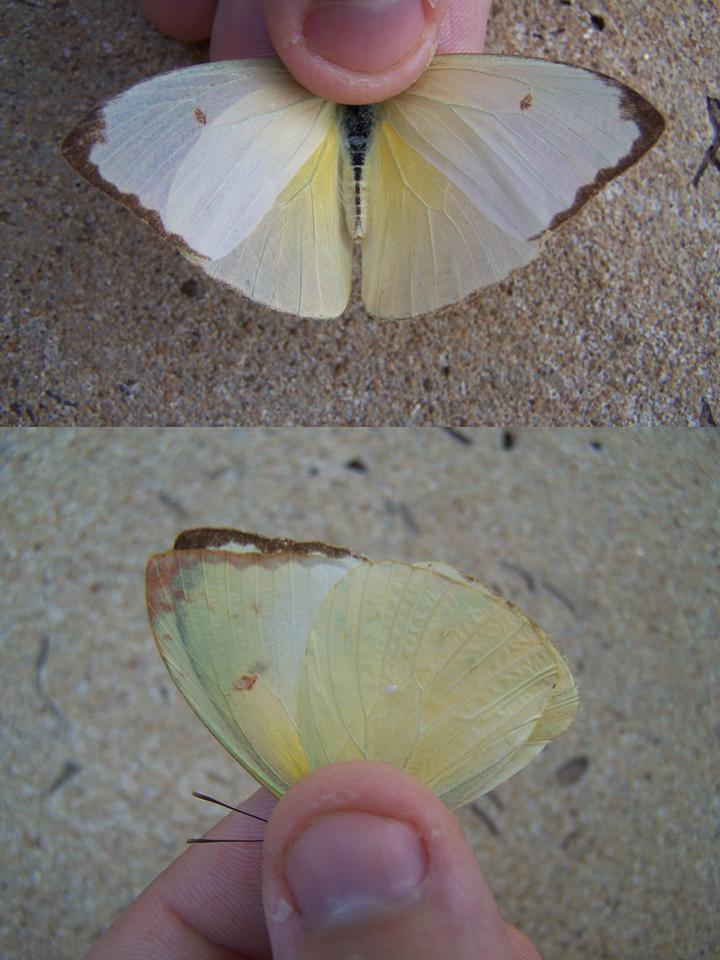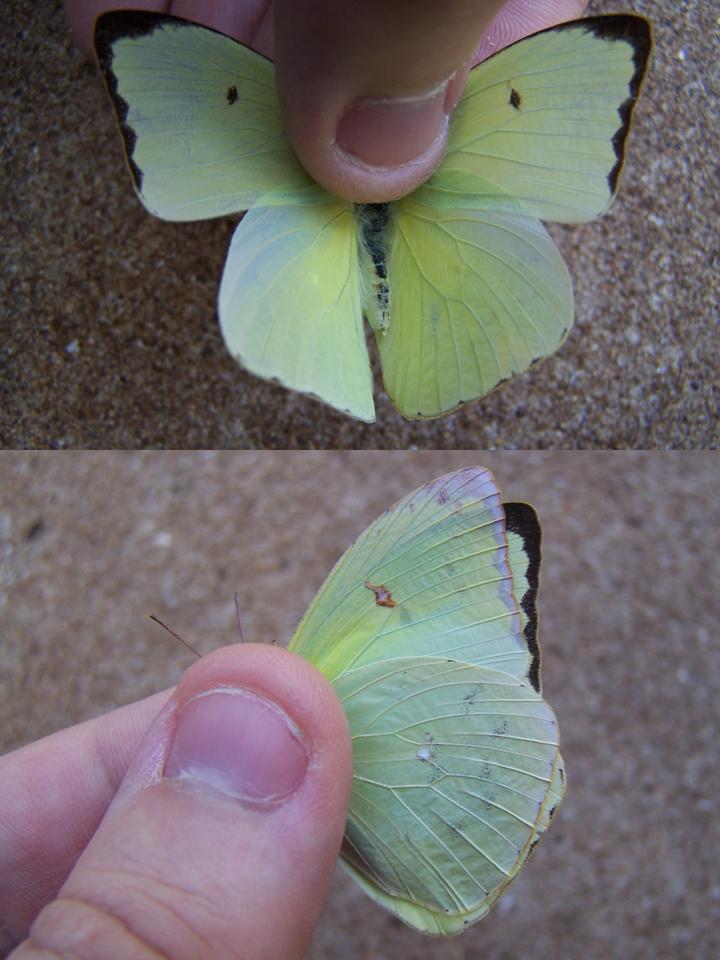

Designed by Paul Smith 2006. This website is copyrighted by law. Material contained herewith may not be used without the prior written permission of FAUNA Paraguay. Photographs on this web-site were taken by Paul Smith, Hemme Batjes, Regis Nossent,
Alberto Esquivel, Arne Lesterhuis, José Luis Cartes, Rebecca Zarza and Hugo del Castillo and are used with their permission.
Aphrissa statira statira (Cramer 1777)
ENG: Bicoloured Sulphur, Statira Sulphur
ESP: Bicolor, Manifestante
JIZ: Forewings square, slightly pointed at apices, hindwing rounded. Folded wing triangular, tapering slightly towards apex and with undulated outer margin. Sexually dimorphic. Poses with folded wings. FLI: Fluttery but strong and straight.
UPP: M (Fig 1) Bicoloured. Lemon-yellow basally and white towards outer margin. White more extensive on forewing, yellow more extensive on hindwing, the edges of the yellow forming a zig-zag pattern across the open upperwing. F (Fig 2-3) Whitish forewing with fairly broad dark brown edges to apices and wavy dark brown edge to outer margin of forewing. Single small brown median spot on forewing. Hindwing white with pale yellow blush basally.
UND: Relatively unmarked. M (Fig 1) Unmarked lemon-yellow slightly deeper basally and whiter towards apex of forewing. F (Fig 2-3) Pale greenish-yellow with rust-brown margin of forewing mirroring upperwing pattern. Single smudgy rust-brown median spot on forewing and indistinct small white, unbordered median spot on hindwing.
BOD: Head and abdomen pale yellow in M (Fig 1), yellow-white in F (Fig 2-3). Upperside of thorax black with sparse yellow-white hairs. Antennae brown with whitish-yellow tip, some specimens with a pinkish spot at the antennae base. Eyes bicoloured, brown above greenish-yellow below. Proboscis black. Legs yellow-white.
MMT: A medium-small Sulphur. No significant sexual difference in measurements. CL - 30.7mm(30-32mm); BL - 22.6mm (20-26mm); AB - 10.5mm; WS - 62.4mm (58-64mm); HW - 3.4mm (3-3.5mm); AL - 12.7mm (12-13mm); n=7 (4M 3F).
SSP: M with their two-tone upperwing pattern should be readily identifiable. F are almost unmarked on the underwing and have a distinctly greenish-yellow tone that is unlike other species. Note that females of both Phoebis argante and Phoebis sennae have vaguely similar upperwing patterns, but both are much more extensively marked black on the wing margins of both wings (particularly the former species) and both have conspicuous brownish scribbles on the underwing.
ABU: Common to abundant often occurring in large numbers with other Coliadinids at flowering bushes. Greatest abundance from January to May.
HAB: Widespread in open areas including gardens.
HOS: Plants in the family Fabaceae including Cassia, Dalbergia, Calliandra and Bignoniaceae including Callichamys latifolia. (Canals 2003).
Citable Reference: Smith P (2007) FAUNA Paraguay Online Handbook of Paraguayan Fauna Butterfly Species Account 1 Aphrissa statira.
Last Updated: 3 September 2007.
References:
Canals G 2003 Mariposas de Misiones - LOLA, Buenos Aires.
 | FIGURE 1 |
|
 | FIGURE 2 |
|
 | FIGURE 3 |
|
FIGURES 1 - PROCOSARA, PN San Rafael (Paul Smith March 07); 2 - Encarnación, Departamento Itapúa (Paul Smith 17 April 07); 3 - Encarnación, Departamento Itapúa (Paul Smith 9 May 07);

